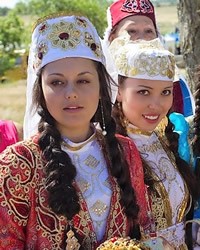Armenian in Russia

Photo Source:
Anonymous
|
Send Joshua Project a map of this people group.
|
| People Name: | Armenian |
| Country: | Russia |
| 10/40 Window: | No |
| Population: | 943,000 |
| World Population: | 6,018,800 |
| Primary Language: | Armenian |
| Primary Religion: | Christianity |
| Christian Adherents: | 94.00 % |
| Evangelicals: | 10.65 % |
| Scripture: | Complete Bible |
| Ministry Resources: | Yes |
| Jesus Film: | Yes |
| Audio Recordings: | Yes |
| People Cluster: | Armenian |
| Affinity Bloc: | Eurasian Peoples |
| Progress Level: |
|
Introduction / History
Throughout history, Armenia has been a battlefield for many invaders and contending empires, and a bridge for many cultures and civilizations. During the past 2,700 years, Armenia has been conquered by the Persian Empire, Alexander the Great, the Roman Empire, the Byzantines, Arabs, Mongols, Tatars, Ottomans, Persians, and Russians. Armenian kingdoms, principalities, and even a short-lived empire (95-55 B.C.) managed to survive and thrive for some 1,700 years. Under various kings and princes, the Armenians developed a sophisticated culture, an original architecture, and their own alphabet.The 1905 Russian revolution and the 1908 Young Turk revolution raised the hopes of the Armenians for reform, and an opportunity to build a homeland in historical Armenia. These hopes were dashed as the Ottoman and the Russian Empires fought each other during World War I. A dark hour of Armenian history is the Armenian genocide, which started on April 24, 1915. Some 1,750,000 Armenians were deported into Syria and Mesopotamia by the Ottoman authorities. Subject to famine, disease, and systematic massacres, most of them perished. This "ethnic cleansing" of the Armenians from their historical homeland led Raphael Lemkin, the father of the Genocide Treaty, to coin the new term "genocide" in the 1930s to describe the historical plight of the Assyrians and the Armenians as subjects of the first genocide of the 20th century. Armenia gained independence on September 23, 1991.Today, there are several million Armenians worldwide. Significant numbers are located in Armenia and the United States of America. Major diaspora centers of the Middle East are Iran, Syria, and Lebanon. There are also Armenian communities in some of the European and Latin American countries. One of their largest population centers is in Russia. Russia hosts the largest Armenian diaspora community globally. Armenian-Russian relations date back to the 11th-12th centuries.
What Are Their Lives Like?
Since the 18th century, multiple Armenian schools have opened to incorporate Armenian traditions alongside their school curriculum. Armenians in Russia not only thrived with legal privileges but also economic privileges, growing ties with the Russian communities. Both cultures have had a significant impact on one another. Following the collapse of the USSR, the social and cultural life of Armenian communities began to rise, and an unprecedented influx of Armenians migrated to Russia. Many Armenians in Russia are highly integrated economically, with high roles in business and diplomacy since the early migrants. However, a significant number of labor migrants work to support their families in Armenia, as occupational security and financial stability are less stable there.Since migrating to Russia, Armenians have adapted to more of the Russian way of life, influenced by their food, language, and lifestyle. However, they still uphold their identity- particularly through community organizations and frequent travel to Armenia for national holidays and celebrations. Preserving their identity, Armenians are highly involved in community groups such as dance, choir, church groups, schools, and political groups. With the majority of the Armenians being involved in the business of trade, infrastructure development, and philanthropy, they play a critical role in fostering economic and political ties between Russia and Armenia.
What Are Their Beliefs?
In 301 AD, during the rule of King Dirtad III, Armenia became the world's first Christian nation. A Christian monk, commonly known as Krikor Lusavorich or St. Gregory the Illuminator, cured the King of a disease. After this event, King Dirtad III was baptized and accepted Christianity as Armenia's official state religion. Before this, two disciples had brought Christianity to Armenia, St. Thaddeus and St. Bartholomew. The root of the tight Armenian community was due to the Armenian Apostolic Church in Astrakhan, established in 1717, playing a significant role in uniting the Armenians as a people.Spiritually, Armenians are still Christian, but their faith in Christ has often taken the back seat to nationalism or a faith in their heritage. Every generation needs a fresh work of the Holy Spirit to move them to full devotion to Jesus Christ.
What Are Their Needs?
Armenians need the Holy Spirit to move in their families and their churches so they can enjoy the abundant life that only Jesus offers.
Prayer Points
Pray for the Armenians in Russia to be salt and light to those who don't know the only Savior.Pray for spiritual peace; this is what Armenia needs most of all.Pray that God would bring revelation of Christianity as a spiritual relationship, and that Armenians would realize they can have joy and peace as they follow the Lord.Pray for their businesses to flourish as a testimony of God's power and goodness.Pray that Armenians would notice the blessings of God in the security they have in other countries post genocide.Pray that God would be the throne of the Armenian's hearts and minds as they flourish in business to glorify Christ.